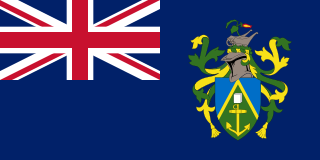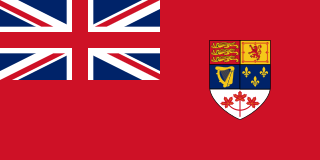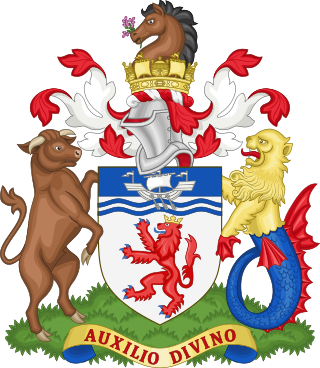Duke of Cornwall is a title in the Peerage of England, traditionally held by the eldest son of the reigning British monarch, previously the English monarch. The duchy of Cornwall was the first duchy created in England and was established by a royal charter in 1337. The present duke is Prince William. His wife, Catherine, is the current duchess of Cornwall.

The Arms of Canada, also known as the Royal Coat of Arms of Canada or formally as the Arms of His Majesty the King in Right of Canada, is, since 1921, the arms of dominion of the Canadian monarch and thus also the official coat of arms of Canada. It is closely modelled after the royal coat of arms of the United Kingdom with French and distinctive Canadian elements replacing or added to those derived from the British version.

Cornwall is a city in Eastern Ontario, Canada, situated where the provinces of Ontario and Quebec and the state of New York converge. It is the seat of the United Counties of Stormont, Dundas, and Glengarry and is Ontario's easternmost city.

The Red Ensign or "Red Duster" is the civil ensign of the United Kingdom of Great Britain and Northern Ireland. It is one of the British ensigns, and it is used either plain or defaced with a badge or other emblem, mostly in the right half.

The original coat of arms of New Brunswick was granted to New Brunswick by a Royal Warrant of Queen Victoria on May 26, 1868. The provincial flag is a banner of the arms.

The coat of arms of Quebec was adopted by order-in-council of the Government of Quebec on 9 December 1939, replacing the arms assigned by royal warrant of Queen Victoria on 26 May 1868.

The coat of arms of Ontario is the heraldic symbol representing the Canadian province of Ontario. The arms contains symbols reflecting Ontario's British heritage along with local symbols. At the upper part of the shield is the red cross of St. George, representing England. The lower portion of the shield features three golden maple leaves on a green background.

The coat of arms of the Pitcairn Islands is an official emblem of the British Overseas Territory of the Pitcairn Islands, alongside the flag of the Pitcairn Islands, and was granted by royal warrant on 4 November 1969. The flag, which consists of a Blue Ensign displaying the coat of arms, was granted on 2 April 1984.

The coat of arms of Toronto, Ontario, Canada, was designed by Robert Watt, the Chief Herald of Canada at the time, for the City of Toronto after its amalgamation in 1998. The arms were granted by the Canadian Heraldic Authority on 11 January 1999.

The coat of arms of Queensland is the oldest in Australia, and was first granted by Queen Victoria in 1893 through the simplest form of heraldic grants; with the shield of arms, motto, helmet, mantling and crest.

The Canadian Red Ensign served as a nautical flag and civil ensign for Canada from 1892 to 1965, and later as the de facto flag of Canada before 1965. The flag is a British red ensign, with the Royal Union Flag in the canton, adorned with the shield of the coat of arms of Canada.

The first coat of arms of Montreal was designed by Jacques Viger, the first mayor of Montreal, and adopted in 1833 by the city councillors. Modifications were made some one hundred five years later and adopted on 21 March 1938, and again on 13 September 2017, resulting in the version currently in use. The coat of arms was the only city emblem representing Montreal until 1981, when a stylized logo was developed for common daily use, reserving the coat of arms for ceremonial occasions.

The Canadian Heraldic Authority is part of the Canadian honours system under the Canadian monarch, whose authority is exercised by the Governor General of Canada. The authority is responsible for the creation and granting of new coats of arms, flags, and badges for Canadian citizens, government agencies, municipal, civic and other corporate bodies. The authority also registers existing armorial bearings granted by other recognized heraldic authorities, approves military badges, flags, and other insignia of the Canadian Forces, and provides information on heraldic practices. It is well known for its innovative designs, many incorporating First Nations symbolism.

The coat of arms of Ottawa was presented to the municipality of Ottawa by Vincent Massey on 20 October 1954.

The coat of arms of Jersey is the heraldic device consisting of a shield charged with three gold leopards on a red field. Utilised unofficially before the 20th century, its status as the coat of arms of the Bailiwick of Jersey was formalized in 1907. The escutcheon is featured on the flag of the dependency.

The flag of Windsor, Ontario, was designed by Hector Lacasse, former mayor of adjacent Tecumseh, during a local contest in 1971. The blue and white represent the Detroit River and Saint Lawrence Seaway, respectively. The flag contains the seal of the city in the upper left and a rose in the lower right, highlighting Windsor's alternate motto, "The Rose City"/"City of Roses." The city seal was replaced in 1992 by a corporate seal. The date of 1854 on the seal signifies the final date in which the railroad to Windsor was completely built and the city was formed by the amalgamation of several other settlements. It is also the date that it was founded as a town.

Devon County Council is the county council administering the English county of Devon. Based in the city of Exeter, the council covers the non-metropolitan county area of Devon. Members of the council (councillors) are elected every four years to represent the electorate of each county division, almost all being nominated by the major national political parties.

Canadian heraldry is the cultural tradition and style of coats of arms and other heraldic achievements in both modern and historic Canada. It includes national, provincial, and civic arms, noble and personal arms, ecclesiastical heraldry, heraldic displays as corporate logos, and Canadian blazonry.
Greater London does not currently have an official flag to represent the region. However, the current Greater London Authority and predecessor bodies have historically flown and used many flags and symbols.

The following is an armorial of the thirty individuals, who have served as governor general of Canada since Confederation.




















